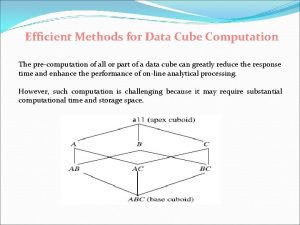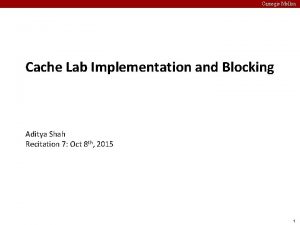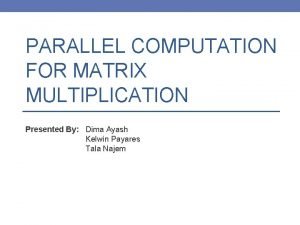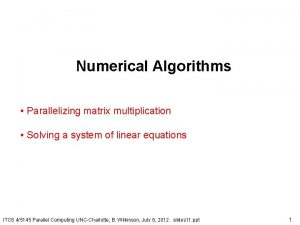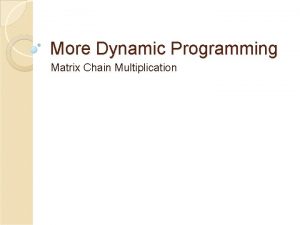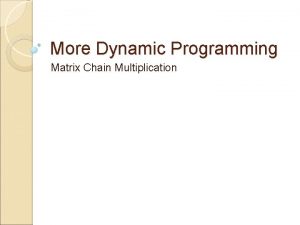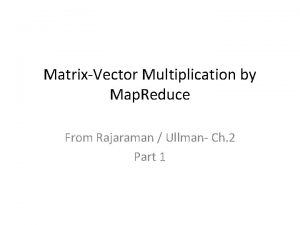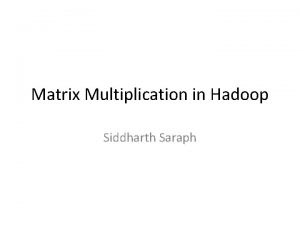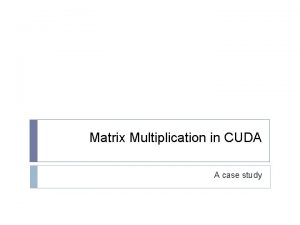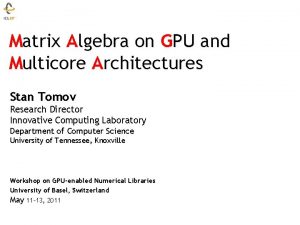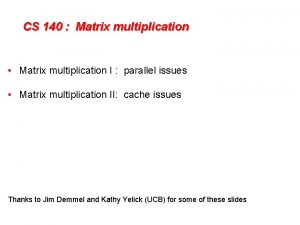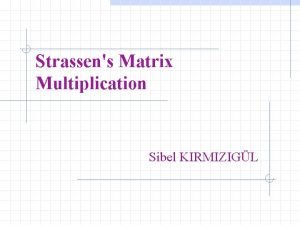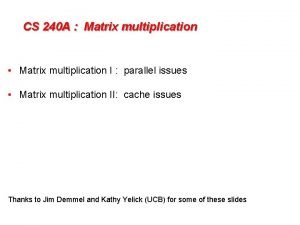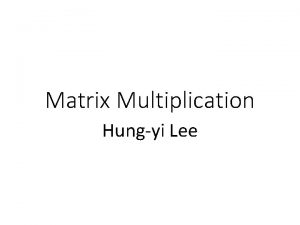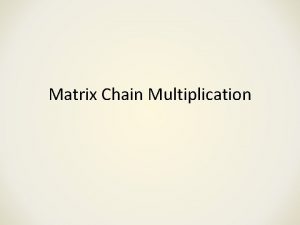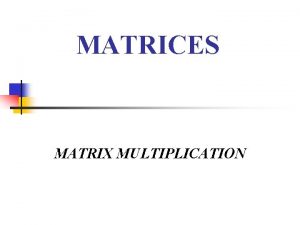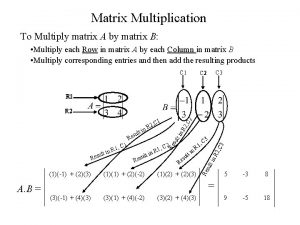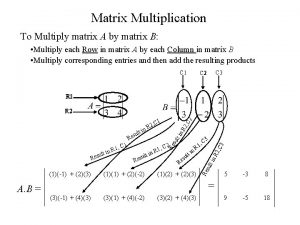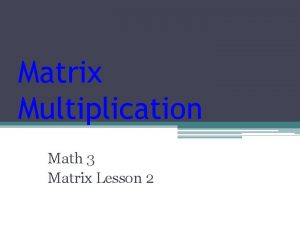Efficient Matrix Multiplication Methods to Implement a Nearoptimum





![The min-ISI method [Arslan, Evans, Kiaei, 2000] Observation: Given a channel impulse response of The min-ISI method [Arslan, Evans, Kiaei, 2000] Observation: Given a channel impulse response of](https://slidetodoc.com/presentation_image_h2/bb5defe3ce01ac90ad596cb15d658526/image-6.jpg)








- Slides: 14

Efficient Matrix Multiplication Methods to Implement a Near-optimum Channel Shortening Method for DMT Transceivers O(NNw) QH S (DH)T Q DH Jeffrey Wu, Güner Arslan, Dr. Brian L. Evans The University of Texas at Austin Asilomar Conference October 30, 2000 A

Why DMT? Typical frequency response of ADSL channels Typical noise spectrum of ADSL channels Solution: Partition channel into subchannels using FFT

Simplest possible DMT transceiver Transmitter Channel Receiver Data in Data out S/P QAM IFFT P/S D/A A/D S/P FFT FEQ QAM P/S “–Houston, we have a problem…” Symbol 1 ISI Symbol 2

Solution to the ISI problem Transmitter Receiver CP CP in out S/P QAM IFFT P/S D/A Ouch! Symbol 1 CP A/D TEQ S/P FFT FEQ QAM P/S Ahhh… Symbol 2 • CP creates room between symbols • TEQ shortens channel to fit within CP

Goal: Given a CP of length ν, design the TEQ such that it shortens channel to ν + 1 sample periods. Objection: But this is generally impossible to do perfectly! Revised Goal: Design TEQ so that it minimizes ISI in such a way that maximizes channel capacity. Response: Sounds good, but how do accomplish that?
![The minISI method Arslan Evans Kiaei 2000 Observation Given a channel impulse response of The min-ISI method [Arslan, Evans, Kiaei, 2000] Observation: Given a channel impulse response of](https://slidetodoc.com/presentation_image_h2/bb5defe3ce01ac90ad596cb15d658526/image-6.jpg)
The min-ISI method [Arslan, Evans, Kiaei, 2000] Observation: Given a channel impulse response of h and an equalizer w, there is a part of h * w that causes ISI and a part that doesn’t. Causes ISI (will extend beyond cyclic prefix) Equalized impulse response, h*w Does not cause ISI (will stay within cyclic prefix) • The length of the window is ν + 1 • Heuristic determination of the optimal window offset, denoted as Δ, is given by Lu (2000).

Matrix ingredients of the min-ISI method 1) The equalizer w. This is a little vector. w 2) The convolution matrix H, such that (Hw)k = (h * w)k. H w 3) The windowing matrix D. This is a diagonal matrix that D isolates the part of h * w causing ISI. H w 4) The FFT matrix Q. Takes FFT of DHw. D Q 5) The weighting matrix diag(S). H w D S Q H w

The Optimization Problem Goal: Find w that minimizes Translation: Find w that minimizes a weighted sum of the ISI power gains in each subchannel. Something is missing here… a constraint! Constrain , where G = I – D Translation: Prevent w from also minimizing the desired part of the h * w!

The Matrix Multiplication Problem (finally!) The optimization problem can be restated as: Minimize w. TAw, where A is defined as QH Q S HT D DT H = A Subject to w. TBw = 1, where B is HT GT G H = B A and B are small, so problem can be solved quickly so long as we can find A and B. Turns out to be a BIG problem for real-time implementation.

The Solution to the Problem – Sliding Windows Arises frequently with Toeplitz matrices (i. e. H) Sliding windows for single sums: Subtract Add Sliding windows for double sums: Subtract Add

Fast Algorithm for Matrix B Explicit formula: The sliding window: The recursion: Very nice! What is going on…

Fast Algorithm for Matrix A Explicit formula: Recursive formula: where The sliding window: where

Variants of the algorithm Row-rotation method • “Rotates” the rows in the convolution matrix H to simplify the explicit formula of A to one double sum. • Assumes last few samples of impulse response close H to zero. GOOD assumption. • Virtually same performance as original method. No-weighting method • Assuming equal weighting of subchannels in the optimization problem. Equivalent to maximum SSNR method by Melsa, Younce, and Rohrs (1996). • Simplifies calculation of A to a single sum. • Almost as good performance as original method. RH R

Results Method Channel SSNR Complexity capacity % (d. B) MACs Original min-ISI 99. 6 37. 8 ½ (N + ν) Nw (Nw + 1) + 5 N (Nw – 1) + NNw 132896 Recursive min. ISI 99. 5 37. 9 4(Nw – 1) (N + 4 Nw – ν – 2) + Nw (N + Nw – 1) + N 44432 Row rotation min-ISI 99. 5 37. 5 2(Nw – 1) (N + 2 Nw – ν – 2) + Nw (N + Nw – 1) + N 25872 Original max SSNR 97. 9 58. 9 ½ N Nw(Nw + 1) 78836 No-weighting min-ISI 97. 8 55. 4 N Nw + 5 Nw (Nw – 1) 10064 N = size of FFT Nw = size of TEQ ν = size of cyclic prefix Channel used : CSA loop 1 System margin: 6 d. B N = 512, Nw = 17, ν = 32
 Productively efficient vs allocatively efficient
Productively efficient vs allocatively efficient Allocative efficiency
Allocative efficiency C b a d
C b a d Productively efficient vs allocatively efficient
Productively efficient vs allocatively efficient Allocative efficiency vs productive efficiency
Allocative efficiency vs productive efficiency Data cube computation methods
Data cube computation methods Cache lab cmu
Cache lab cmu Fox algorithm matrix multiplication
Fox algorithm matrix multiplication Matrix multiplication time complexity
Matrix multiplication time complexity Matrix chain multiplication definition
Matrix chain multiplication definition Dynamic programming matrix multiplication
Dynamic programming matrix multiplication Matrix vector multiplication by mapreduce
Matrix vector multiplication by mapreduce Hadoop matrix multiplication
Hadoop matrix multiplication Cuda matrix multiplication
Cuda matrix multiplication Algebra
Algebra





